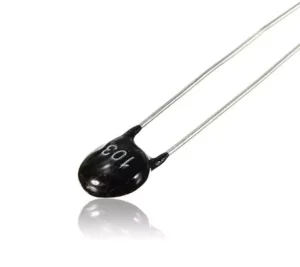What is the Thermistor Sensor?
a thermistor sensor is a type of temperature-sensitive resistor that exhibits a change in resistance with changes in temperature. Unlike regular resistors which have a consistent resistance value, thermistors are designed to be highly sensitive to temperature variations. This unique characteristic makes them ideal for precise temperature measurement and control applications.
The word “thermistor” itself is a combination of “thermal” and “resistor”, reflecting the sensor’s ability to respond to thermal changes by altering its electrical resistance. A thermistor is a type of resistor that use to sense cold and heat.
They are reliable, cheap and responds quickly, therefore, they are used for simple low temperature but not for high temperature.
They are used in home appliances, refrigerators, and circuit protection.
Related Articles:
- Interfacing Thermistor with Arduino
- IR Receiver and Remote with Arduino
- Servo Motor with an Arduino
- LDR Sensor with Arduino
Thermistors are of two opposite fundamental types:
- NTC Thermistor (Negative temperature coefficient):- In NTC thermistors, as the temperature increases, the resistance decreases. They are commonly uses as temperature sensors. The suitable temperature range is between -55°C to +150°C.
- PTC thermistors (Positive temperature coefficient):- PTC thermistors exhibit an increase in resistance with rising temperatures. This type often serves in overcurrent protection devices, self-regulating heaters, and motor starting circuits.

Pinout of Thermistor Sensor
A thermistor sensor typically consists of two pins for connectivity – one for power input and the other for ground connection. These pins allow the sensor to accurately measure temperature variations within a circuit.
How Does a Thermistor Sensor Work?
Thermistor sensors operate on the principle of resistance change with temperature variations. These sensors consist of a resistor made from metal oxides, allowing them to exhibit a significant change in resistance as the temperature changes. When exposed to heat, the thermistor’s resistance decreases, and conversely, it increases when cooled.
This unique characteristic enables thermistors to accurately measure temperature fluctuations within a specific range. By monitoring these resistance changes, thermistor sensors can provide real-time data on environmental conditions or equipment performance. This data is then converted into electrical signals that can be analyzed and interpreted by connected devices or systems for further action.
Applications
Various industries widely use thermistor sensors due to their precision and reliability.
- One common application is temperature sensing in heating, ventilation, and air conditioning (HVAC) systems. Thermistors help regulate the temperature inside buildings to ensure comfort and energy efficiency.
- In the automotive industry, this sensors play a crucial role in monitoring engine temperatures. They help prevent overheating and optimize fuel combustion for better performance.
- Additionally, medical devices such as blood pressure monitors and fever thermometers utilize thermistors to accurately measure body temperature.
- Another important application of thermistor sensors is in food storage and transportation. By monitoring temperature variations, these sensors help maintain the freshness and quality of perishable goods during transit.
- In industrial processes, thermistors are essential for controlling temperatures in manufacturing equipment to ensure product consistency.
Advantages and Disadvantages of Using a Thermistor Sensor
When it comes to thermistor sensors, there are several advantages worth considering. One of the main benefits is their high sensitivity to temperature changes, offering precise and accurate measurements. Additionally, thermistors are compact in size and cost-effective compared to other temperature sensing options.
Another advantage is their wide operating temperature range, making them suitable for a variety of applications across different industries. Thermistors also have a fast response time, allowing for real-time monitoring and control in critical processes.
However, there are some drawbacks to using thermistor sensors as well. One common limitation is their non-linear resistance-temperature characteristics, which may require calibration for certain applications. Additionally, they can be more susceptible to self-heating effects compared to other types of temperature sensors.